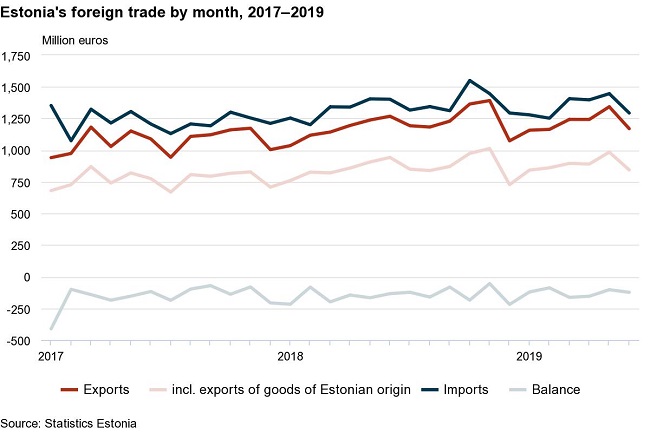Analytics, Estonia, Foreign trade , Statistics
International Internet Magazine. Baltic States news & analytics
Wednesday, 24.04.2024, 04:33
Estonia: In June, trade decreased y-o-y
 Print version
Print versionIn June 2019, exports from Estonia amounted to 1.2 bn euros
and imports to Estonia to 1.3 bn euros at current prices. The trade
deficit was 124 mln euros, which was 10 mln euros less than in the same period
last year.
In June 2019, the top destination countries of Estonia’s
exports were Finland (16% of Estonia’s total exports), Sweden (12%) and Latvia
(9%). Electrical equipment and base metals and articles of base metal were the
main commodities exported to Finland; miscellaneous manufactured articles
(prefabricated wood buildings) and transport equipment (ships) to Sweden;
agricultural products and food preparations (milk, beer) and mineral products
(fuel additives, electricity) to Latvia. The biggest decrease occurred in
exports to Singapore (down by 43 mln euros), followed by Latvia (down by 31 mln
euros) and Norway (down by 27 mln euros). In exports to Singapore and Latvia,
the biggest decrease occurred in the exports of mineral products; and to
Norway, in the exports of miscellaneous manufactured articles (prefabricated
wood buildings). The biggest increase occurred in exports to Denmark (up by 26 mln
euros).
In June, the biggest share in exports of goods was held by
electrical equipment (16% of Estonia’s total exports), followed by mineral
products (12%), and wood and articles of wood (10%). The biggest impact on
export decrease came from mineral products (down by 59 mln euros), and wood and
articles of wood (down by 20 mln euros). At the same time, exports of transport
equipment increased.
The share of goods of Estonian origin in total exports was
72% in June. The exports of goods of Estonian origin decreased by 10% while
re-exports stayed at the same level, year-on-year. In the exports of goods of
Estonian origin, the biggest decrease was in the exports of mineral products
(gas oils, shale oil) and wood and articles of wood (pulpwood, sawn timber).
In June, the main countries of consignment were Finland (13%
of Estonia’s total imports), Sweden (11%), Lithuania and Germany (both 10%).
The main commodities imported were: mineral products and electrical equipment
from Finland; transport equipment and electrical equipment from Sweden; mineral
products and agricultural products and food preparations from Lithuania; and
transport equipment and mechanical appliances from Germany. Imports decreased
the most from Belarus (down by 42 mln euros), the United Kingdom (down by 17 mln
euros) and the Netherlands (down by 16 mln euros). From Belarus and the United
Kingdom, the imports of mineral products, and from the Netherlands, the imports
of electrical equipment decreased the most. Imports increased the most from
Sweden (up by 27 mln euros) due to an increase in the imports of electrical
equipment.
The main commodities imported to Estonia were transport
equipment and mineral products (both 13% of Estonia’s total imports) and
electrical equipment (12%). The biggest decrease was in the imports of mineral
products (down by 80 mln euros) and electrical equipment (down by 22 mln
euros). At the same time, the biggest increase was in the imports of transport
equipment (up by 23 mln euros).
In the 2nd quarter of 2019, exports of goods from Estonia
amounted to 3.8 bn euros and imports to Estonia to 4.1 bn euros. The trade
deficit in the 2nd quarter was 382 mln euros (in the 2nd quarter of 2018, it
was 447 mln euros).
In the 2nd quarter of 2019, the growth in exports compared
to the same period of the previous year was 1% and imports stayed at the same
level. The growth in exports was slowed down the most by decreased exports of
mineral products (down by 47 mln euros). In the 2nd quarter, the biggest
increase in exports occurred in transport equipment (up by 39 mln euros),
agricultural products and food preparations (up by 25 mln euros). In the
comparison of countries, exports have increased the most to the Netherlands (up
by 67 mln euros), the USA (up by 58 mln euros) and Spain (up by 56 mln euros).
At the same time, exports have decreased the most to Latvia (down by 47 mln
euros) and Singapore (down by 42 mln euros).
In the 2nd quarter of 2019 compared to the 2nd quarter of
2018, imports was significantly affected by a decrease in mineral products
(down by 151 mln euros), and such a large decline could not be compensated by
increased imports of transport equipment (up by 44 mln euros), agricultural
products and food preparations (up by 32 mln euros), and raw materials and
products of chemical industry (up by 25 mln euros). Imports grew the most from
Sweden (up by 84 mln euros) and Russia (up by 37 mln euros) and decreased the
most from Belarus (down by 111 mln euros) and the Netherlands (down by 52 mln
euros).









 «The Baltic Course» Is Sold and Stays in Business!
«The Baltic Course» Is Sold and Stays in Business!

